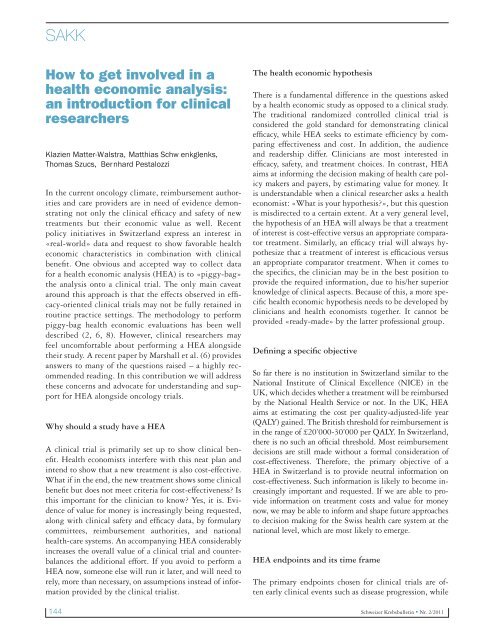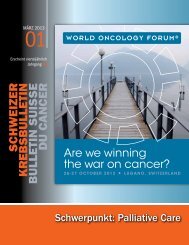Krebsforschung in der Schweiz - SAKK – Swiss Group for Clinical ...
Krebsforschung in der Schweiz - SAKK – Swiss Group for Clinical ...
Krebsforschung in der Schweiz - SAKK – Swiss Group for Clinical ...
Sie wollen auch ein ePaper? Erhöhen Sie die Reichweite Ihrer Titel.
YUMPU macht aus Druck-PDFs automatisch weboptimierte ePaper, die Google liebt.
<strong>SAKK</strong>How to get <strong>in</strong>volved <strong>in</strong> ahealth economic analysis:an <strong>in</strong>troduction <strong>for</strong> cl<strong>in</strong>icalresearchersKlazien Matter-Walstra, Matthias Schw enkglenks,Thomas Szucs, Bernhard PestalozziIn the current oncology climate, reimbursement authoritiesand care provi<strong>der</strong>s are <strong>in</strong> need of evidence demonstrat<strong>in</strong>gnot only the cl<strong>in</strong>ical effi cacy and safety of newtreatments but their economic value as well. Recentpolicy <strong>in</strong>itiatives <strong>in</strong> Switzerland express an <strong>in</strong>terest <strong>in</strong>«real-world» data and request to show favorable healtheconomic characteristics <strong>in</strong> comb<strong>in</strong>ation with cl<strong>in</strong>icalbenefi t. One obvious and accepted way to collect data<strong>for</strong> a health economic analysis (HEA) is to «piggy-bag»the analysis onto a cl<strong>in</strong>ical trial. The only ma<strong>in</strong> caveataround this approach is that the effects observed <strong>in</strong> effi -cacy-oriented cl<strong>in</strong>ical trials may not be fully reta<strong>in</strong>ed <strong>in</strong>rout<strong>in</strong>e practice sett<strong>in</strong>gs. The methodology to per<strong>for</strong>mpiggy-bag health economic evaluations has been welldescribed (2, 6, 8). However, cl<strong>in</strong>ical researchers mayfeel uncom<strong>for</strong>table about per<strong>for</strong>m<strong>in</strong>g a HEA alongsidetheir study. A recent paper by Marshall et al. (6) providesanswers to many of the questions raised <strong>–</strong> a highly recommendedread<strong>in</strong>g. In this contribution we will addressthese concerns and advocate <strong>for</strong> un<strong>der</strong>stand<strong>in</strong>g and support<strong>for</strong> HEA alongside oncology trials.Why should a study have a HEAA cl<strong>in</strong>ical trial is primarily set up to show cl<strong>in</strong>ical benefit. Health economists <strong>in</strong>terfere with this neat plan and<strong>in</strong>tend to show that a new treatment is also cost-effective.What if <strong>in</strong> the end, the new treatment shows some cl<strong>in</strong>icalbenefi t but does not meet criteria <strong>for</strong> cost-effectiveness? Isthis important <strong>for</strong> the cl<strong>in</strong>ician to know? Yes, it is. Evidenceof value <strong>for</strong> money is <strong>in</strong>creas<strong>in</strong>gly be<strong>in</strong>g requested,along with cl<strong>in</strong>ical safety and effi cacy data, by <strong>for</strong>mularycommittees, reimbursement authorities, and nationalhealth-care systems. An accompany<strong>in</strong>g HEA consi<strong>der</strong>ably<strong>in</strong>creases the overall value of a cl<strong>in</strong>ical trial and counterbalancesthe additional ef<strong>for</strong>t. If you avoid to per<strong>for</strong>m aHEA now, someone else will run it later, and will need torely, more than necessary, on assumptions <strong>in</strong>stead of <strong>in</strong><strong>for</strong>mationprovided by the cl<strong>in</strong>ical trialist.The health economic hypothesisThere is a fundamental difference <strong>in</strong> the questions askedby a health economic study as opposed to a cl<strong>in</strong>ical study.The traditional randomized controlled cl<strong>in</strong>ical trial isconsi<strong>der</strong>ed the gold standard <strong>for</strong> demonstrat<strong>in</strong>g cl<strong>in</strong>icaleffi cacy, while HEA seeks to estimate effi ciency by compar<strong>in</strong>geffectiveness and cost. In addition, the audienceand rea<strong>der</strong>ship differ. Cl<strong>in</strong>icians are most <strong>in</strong>terested <strong>in</strong>effi cacy, safety, and treatment choices. In contrast, HEAaims at <strong>in</strong><strong>for</strong>m<strong>in</strong>g the decision mak<strong>in</strong>g of health care policymakers and payers, by estimat<strong>in</strong>g value <strong>for</strong> money. Itis un<strong>der</strong>standable when a cl<strong>in</strong>ical researcher asks a healtheconomist: «What is your hypothesis?», but this questionis misdirected to a certa<strong>in</strong> extent. At a very general level,the hypothesis of an HEA will always be that a treatmentof <strong>in</strong>terest is cost-effective versus an appropriate comparatortreatment. Similarly, an effi cacy trial will always hypothesizethat a treatment of <strong>in</strong>terest is effi cacious versusan appropriate comparator treatment. When it comes tothe specifi cs, the cl<strong>in</strong>ician may be <strong>in</strong> the best position toprovide the required <strong>in</strong><strong>for</strong>mation, due to his/her superiorknowledge of cl<strong>in</strong>ical aspects. Because of this, a more specific health economic hypothesis needs to be developed bycl<strong>in</strong>icians and health economists together. It cannot beprovided «ready-made» by the latter professional group.Def<strong>in</strong><strong>in</strong>g a specific objectiveSo far there is no <strong>in</strong>stitution <strong>in</strong> Switzerland similar to theNational Institute of Cl<strong>in</strong>ical Excellence (NICE) <strong>in</strong> theUK, which decides whether a treatment will be reimbursedby the National Health Service or not. In the UK, HEAaims at estimat<strong>in</strong>g the cost per quality-adjusted-life year(QALY) ga<strong>in</strong>ed. The British threshold <strong>for</strong> reimbursement is<strong>in</strong> the range of £20’000-30’000 per QALY. In Switzerland,there is no such an official threshold. Most reimbursementdecisions are still made without a <strong>for</strong>mal consi<strong>der</strong>ation ofcost-effectiveness. There<strong>for</strong>e, the primary objective of aHEA <strong>in</strong> Switzerland is to provide neutral <strong>in</strong><strong>for</strong>mation oncost-effectiveness. Such <strong>in</strong><strong>for</strong>mation is likely to become <strong>in</strong>creas<strong>in</strong>glyimportant and requested. If we are able to provide<strong>in</strong><strong>for</strong>mation on treatment costs and value <strong>for</strong> moneynow, we may be able to <strong>in</strong><strong>for</strong>m and shape future approachesto decision mak<strong>in</strong>g <strong>for</strong> the <strong>Swiss</strong> health care system at thenational level, which are most likely to emerge.HEA endpo<strong>in</strong>ts and its time frameThe primary endpo<strong>in</strong>ts chosen <strong>for</strong> cl<strong>in</strong>ical trials are oftenearly cl<strong>in</strong>ical events such as disease progression, while144 <strong>Schweiz</strong>er Krebsbullet<strong>in</strong> • Nr. 2/2011



